Conclusions: An Assessment of Manufacturing Customer Pain Points: Challenges for Researchers
Conclusions
p. What should manufacturers be doing to improve the level of relational (social) capital in their supply networks through trust and collaboration? We decided to start off this special issue with a managerial look at supply chain pain points as perceived by a group of senior global logistics executives from a number of different Fortune 100 manufacturing companies. We expected these pain points to give us insights into where such companies may be planning to increase collaboration and to risk trust—or where they may be reacting to the downside of such collaboration and trust.
Our review of the 10 pain points identified indicates that trust and collaboration are becoming both more valuable and more costly as supply networks increase in complexity and global manufacturing becomes more competitive. Our findings also make it obvious that executives often debate the possible trade-offs arising from relationships where trust and collaboration is required. Confusion occurs when decision makers toggle between collaborative and transactional relationships.
Research questions arising from these interactions with managers include the following:
- What are the benefits and costs of supply network collaboration? When do benefits outweigh costs? Can a transactions-cost approach be used to quantify benefits of collaboration, or do such benefits remain so intangible that their benefit is difficult to capture and model?
- How can research on relational capital be applied to the supply network context?
- What kind of information is being transferred? How and to whom is it being transferred? What are the implications of the choice of technology used for such transfers?
- How do context variables such as intensity of competition, power shifts, and intellectual property protection affect development of trust and collaboration?
- What new skills are required of supply chain personnel to allow quality decision making about whether and how to invest in relational capital in the network?
- Categories:


